 Back to articles list
Back to articles list
In this article, I’ll make a comparison of two popular database modelers: Vertabelo in version 1.21.0 and Navicat Data Modeler in version 1.0.12.
Features are listed in the left-hand column and each tool’s feature support is identified under the appropriate heading.
| Vertabelo | Navicat Data Modeler | |
|---|---|---|
Online tool
|
Standalone version available for:
|
|
| Model structure | ||
| Tables |

|

|
| References |

|

|
| Sequences |

|

|
| Views |

|

|
| Text Notes |

|

|
| Indexes |

|

|
| Checks |

|

|
| Additional SQL scripts |

|

|
| Supported database engines | ||
|
|
|
| Supported data types | Vertabelo supports a particular database from creation. While creating a diagram, you have access to the appropriate data type. | While modeling, you can change the database engine. |
| Model navigation | ||
| Find table in diagram |

|

|
| Find column in diagram |

|

|
| Grouping tables |

|

|
| Search |

|

|
| Smooth workflow | ||
| Instant save |

|

|
| Live validation |

|

|
| SQL preview |

|

|
| Managing models | ||
| Versioning models |

|

|
| XML import/export |

|

|
| SQL import |

|

|
| SQL generation |

|

|
| Export to pdf |

|

|
| Export to png |

|

|
| Reverse engineering |

|

|
| Migration scripts | planned |

|
| Pricing |
|
|
Creating a model
| Vertabelo | Navicat Data Modeler |
|---|---|
There are four ways to create a model in Vertabelo:
|
You can create a new blank model or open an existing model. Database engine support can be changed during the designing process. |
Tables
| Vertabelo | Navicat Data Modeler |
|---|---|
|
You can add /delete columns as well as:
After creating a reference, the foreign key is automatically added with label FK in the table. Primary key is set in Table properties and is also labeled in the diagram. |
You can edit the table structure in a Table Designer, where you can create, edit and drop:
Additionally, Navicat enables to specify a character set and collation for table field. |
| You can manipulate the size of a table by dragging the corners and can move tables using mouse and arrows. | |
| You can access a SQL preview of a particular element. | SQL preview available after generating SQL/DDL script. |
Manage large diagrams
Each tool allows you to group tables in your design. How table groupings are represented and defined within each tool is described below.

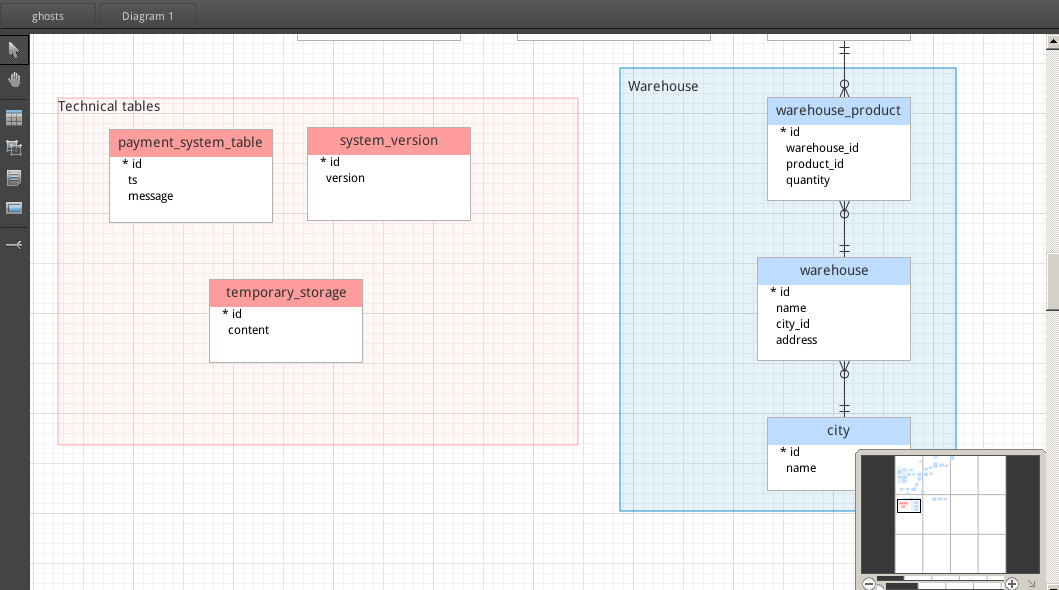
| Vertabelo | Navicat Data Modeler |
|---|---|
| Subject areas To group tables Vertabelo provides Subject areas. They are dashed rectangles that identify the tables, views, references and notes contained within. You can manipulate the size of a subject area and drag the name of a subject area to any place you want: inside of a rectangle or outside the edge. Navigation tree contains a list of all subject areas. From there you can find the table representation, reference, add/delete table and view. |
Layers Navicat uses 'Layers' to group tables. They are rectangles with a note for group description. |
| Shortcuts provide another graphical representation of the same table. | You can't have more than one table representation in the same diagram. |
| You can't have parts of the model in different diagrams. | You can have parts of the model in different diagrams. Diagram tree holds all the objects (tables, layers, notes, images and relations). Model tree holds all the tables in the model, including the tables used in each diagram. From Model tree you can easily copy the appropriate table to the chosen diagram. |
Overview
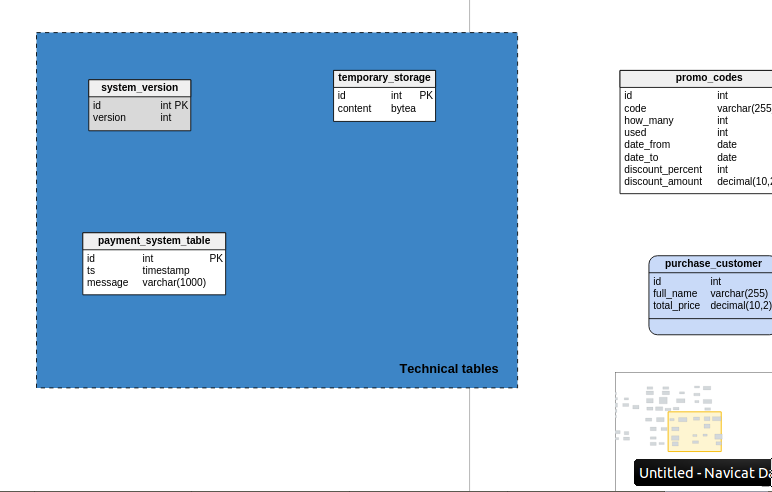
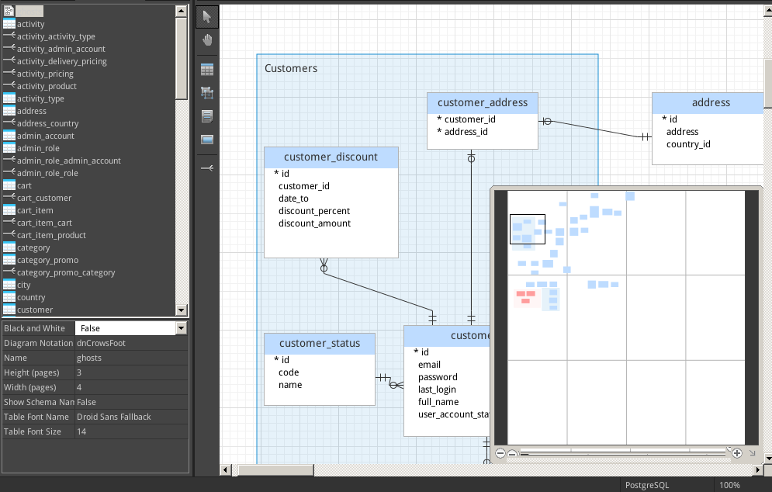
| Vertabelo | Navicat Data Modeler |
|---|---|
| Overview is a map helping navigate the model. While dragging a model in the overview, the position of the model in the view also changes. | Overview helps navigate the model. While zooming the map, the current model switches to the selected size in the map. Moving the current view in the map moves to a particular part of original diagram. |
Sharing diagram and collaboration
Each tool allows you to share a database model. How models are shared within each tool is described below.
| Vertabelo | Navicat Data Modeler |
|---|---|
A key Vertabelo feature is the ability to share your diagram with other users or create a public link presenting the model in read-only mode.
With team collaboration, there are three access levels:
Only one person can edit the model at a time. Others can see the diagram in read-only mode. |
No collaboration support. |
Model versioning
| Vertabelo | Navicat Data Modeler |
|---|---|
| Vertabelo enables Model versions in Model details for each model. After each operation, for example, XML generation, there is an autosave when a version of the model is created. At any time you can return to aparticular version and:
|
No versioning support. However, Navicat includes a 'history palette' that shows all of the actions that have been taken while working on the current diagram in the current session. Double clicking an action restores diagram to selected state. |
Live validation
Only Vertabelo performs live validation on your database model. How this validation functions is described below.
| Vertabelo | Navicat Data Modeler |
|---|---|
| Vertabelo validates your model continuously and gives you hints on how to improve it. Every error, warning or tip is flagged by a dedicated icon and described in Table properties. | No validation. |
Reverse engineering
| Vertabelo | Navicat Data Modeler |
|---|---|
| You can import an existing database into Vertabelo via the Reverse Engineering tool. The Reverse Engineering tool is a simple command-line Java application that you can download from Vertabelo’s website. It connects to your database, reads the table and view details and stores the info in a XML file. Details can be found at: Reverse engineering You may also import a database structure from SQL script. |
You can import an existing database using:
Import from local/remote database: |
Comparison and synchronization (Migrating scripts)
| Vertabelo | Navicat Data Modeler |
|---|---|
| No synchronization script support | Navicat Data Modeler uses the 'Synchronize to database' function to let you view the differences between the new model and the previous one. Then the synchronization script is generated to update the destination database. |
Generate SQL script
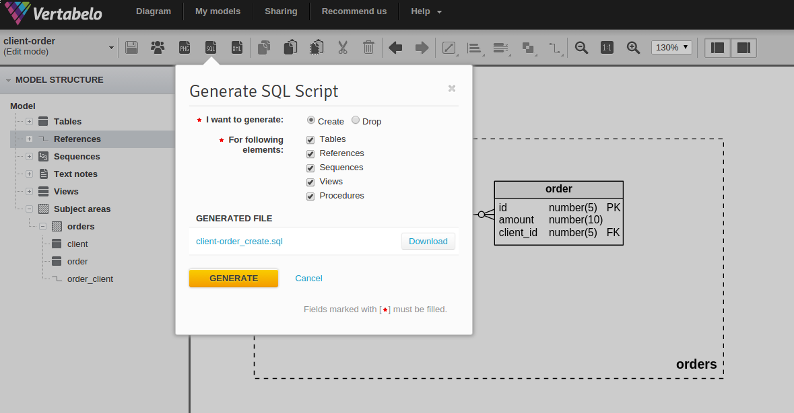
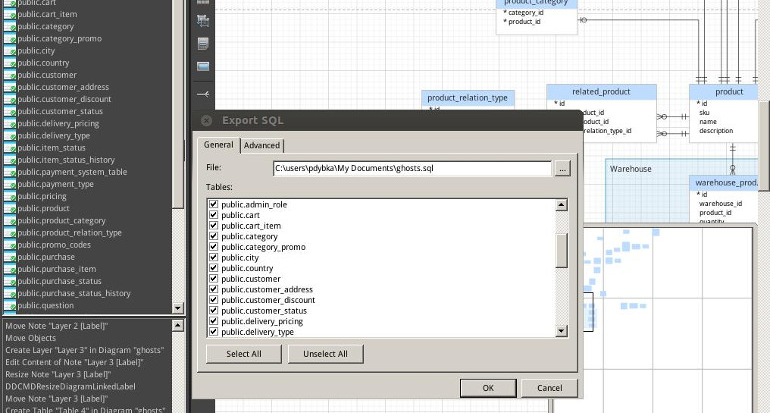
| Vertabelo | Navicat Data Modeler |
|---|---|
At any time you can generate SQL script that:
|
Navicat generates SQL script that creates all the elements/selected elements in your database including referential integrity rules, comments, character sets, etc. |
Interoperability
| Vertabelo | Navicat Data Modeler |
|---|---|
| Vertabelo enables XML export and import. Vertabelo stores your model in an XML format. See how to extract some information using Vertabelo XML To help you incorporate some automation into your build system, Vertabelo provides an API |
No XML import/export support. |


